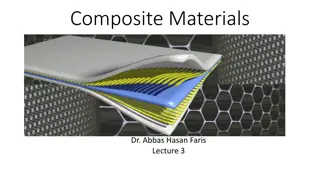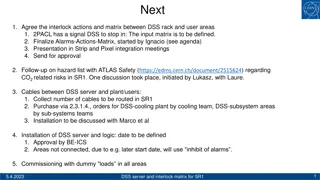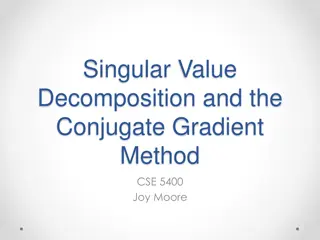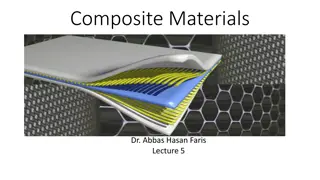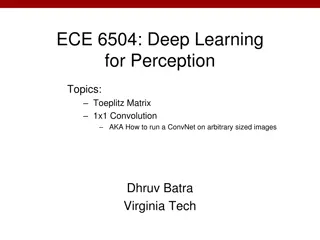Understanding Matrix Operations and Properties
Dive into the world of matrices with this comprehensive guide covering unary operations, matrix transposition, symmetry, trace calculation, and determinant computation. Explore examples and definitions to grasp these fundamental concepts in linear algebra effectively.
Download Presentation

Please find below an Image/Link to download the presentation.
The content on the website is provided AS IS for your information and personal use only. It may not be sold, licensed, or shared on other websites without obtaining consent from the author. Download presentation by click this link. If you encounter any issues during the download, it is possible that the publisher has removed the file from their server.
E N D
Presentation Transcript
Autar Kaw Humberto Isaza http://nm.MathForCollege.com Transforming Numerical Methods Education for STEM Undergraduates
After reading this chapter, you should be able to: 1. know what unary operations means, 2. find the transpose of a square matrix and it s relationship to symmetric matrices, 3. find the trace of a matrix, and 4. find the determinant of a matrix by the cofactor method.
n m n m b = th a [A ] [B ] [A ] m th Let be a matrix. Then is the transpose of the if for all i and j That is, the row and the column element of is the row and column element of . Note would be a matrix. The transpose of is denoted by m n ] [B ] [B n ij ij th [A ] i i th j j T] [A [A ]
Find the transpose of 25 20 3 2 = [A ] 5 10 15 25 6 16 7 27
Solution The transpose of is [A ] 25 5 6 20 10 16 A T = 3 15 7 2 25 27 Note, the transpose of a row vector is a column vector and the transpose of a column vector is a row vector. Also, note that the transpose of a transpose of a matrix is the matrix itself, that is, ( A A = ; cA B A B A + = + ) ( ) ( ) T T T T Also, = T T T cA
a = A square matrix with real elements where for and is called a symmetric matrix. This is same as, if matrix. 2 , 1 = 2 , 1 = a A = [A ] ,..., ,..., i n j n ij ji , then is a symmetric [A T] T] [ ] [ A
Give an example of a symmetric matrix Solution 21 2 . 2 . 3 6 = [A ] 2 . 3 21 5 . 8 6 8 3 . 9 = = = = = a = is a symmetric matrix as and 3 2 . 6 8 a a , a a a 12 21 13 31 23 32
n n A matrix is skew symmetric if for same as and . This is = = = ,..., 1 ,..., 1 i n j n a a ij ji A . A T =
Give an example of a skew-symmetric matrix. Solution 0 1 2 1 0 5 2 5 0 is skew-symmetric as = = = = = = = = all the diagonal elements of a skew-symmetric matrix have to be zero. a . Since only if 5 ii a ; 1 ; 2 0 a a a a a a a 12 21 13 31 23 32 ii ii
n n n n n n The trace of a matrix is the sum of the diagonal entries of , that is, [A ] [A ] n A = tr a ii = 1 i
Find the trace of 15 6 7 = [A ] 2 4 2 3 2 6 Solution 3 A = tr a ii = 1 i = + ) 4 ) 6 ( + 15 ( ) ( = 17
The sales of tires are given by make (rows) and quarters (columns) for Blowout rus store location A, as shown below. = 27 7 16 6 25 20 3 2 [A ] 5 10 15 25 where the rows represent the sale of Tirestone, Michigan and Copper tires, and the columns represent the quarter number 1, 2, 3, 4. Find the total yearly revenue of store A if the prices of tires vary by quarters as follows. = 22 03 . 27 02 . 22 03 . 25 33 25 . 30 01 . 35 02 . 30 05 . [B ] 40 19 . 38 02 . 41 03 . 38 23 . 95 . where the rows represent the cost of each tire made by Tirestone, Michigan and Copper, and the columns represent the quarter numbers.
Solution To find the total tire sales of store for the whole year, we need to find the sales of each brand of tire for the whole year and then add to find the total sales. To do so, we need to rewrite the price matrix so that the quarters are in rows and the brand names are in the columns, that is, find the transpose of [B . ] C = T] [ ] [ B T 33 25 . 30 01 . 35 02 . 30 05 . = 40 19 . 38 02 . 41 03 . 38 23 . 25 03 . 22 02 . 27 03 . 22 95 . 33 25 . 40 19 . 25 03 . 30 01 . 38 02 . 22 02 . = [C ] 35 02 . 41 03 . 27 03 . 30 05 . 38 23 . 22 95 .
Recognize now that if we find , we get [ ][ ] A C D = A C 33 25 . 40 19 . 25 03 . 25 20 3 2 30 01 . 38 02 . 22 02 . = 5 10 15 25 35 02 . 41 03 . 27 03 . 6 16 7 27 30 05 . 38 23 . 22 95 . 1597 1965 1193 = 1743 2152 1325 1736 2169 1311
The diagonal elements give the sales of each brand of tire for the whole year, that is 11= d 22= d 33= d 1597 $ 2152 $ 1311 $ (Tirestone sales) (Michigan sales) (Cooper sales) The total yearly sales of all three brands of tires are 3 + + = = i 5060 $ = 1597 2152 1311 d ii 1 and this is the trace of the matrix [A ]
The determinant of a square matrix is a single unique real number corresponding to a matrix. For a matrix , determinant is denoted by or . So do not use and interchangeably For a 2 2 matrix, A A det(A ) [A ] [A ] a a 11 12 = [ ] A a a 21 22 = det( ) A a a a a 11 22 12 21
Let be matrix. The minor of entry is denoted by and is defined as the determinant of the submatrix of , where the submatrix is obtained by deleting the row and column of the matrix . The determinant is then given by i j [A ] n a M n ij ij [A ] ) 1 ( 1 ( n n [A ] th th n ( ) A ( ) = j + i j = = det 1 any , 1 , 2 , a M for i n ij ij 1 or n ( ) A ( ) = i + i j = = det 1 , 1 , 2 , a M for any j n ij ij 1
( ) A coupled with that , as we can always reduce the determinant of a matrix to determinants of matrices. The number of and is denoted The above equation for the determinant can then be written as ij a = det for a 1 1 1 1 matrix [ ] a A 11 is called the cofactor + ) 1 i j ( M ij ij c n ( ) A = = det , 1 , 2 , a C for any i n ij ij = 1 j or n ( ) A det = = , 1 , 2 , a C for any j n ij ij = 1 i The only reason why determinants are not generally calculated using this method is that it becomes computationally intensive. For a operations proportional to n!. n matrix, it requires arithmetic n
Find the determinant of 25 5 1 = [A ] 64 8 1 144 12 1
Solution 3 ( ) A ( ) = j + i j = = det 1 for any , 1 , 2 3 a M i ij ij 1 Let in the formula 1 = i 3 ( ) A ( ) = j + 1 j = det 1 a M 1 1 j j 1 ( ) ( ) ( ) + + + 1 1 1 2 1 3 = + + 1 1 1 a M a M a M 11 11 12 12 13 13 = + a M a M a M 11 11 12 12 13 13
25 5 1 11= 64 8 1 M 144 12 1 8 1 = 12 1 = 4 25 5 1 12= 64 8 1 M 144 12 1 64 1 = 144 1 = 80
25 5 1 13= 64 8 1 M 144 12 1 64 8 = 144 12 = 384 = + det( ) A a M a M a M 11 11 12 ( 12 13 ( 13 ( ) ) ) = + 25 4 5 80 1 384 = 100 + 400 384 = 84
= Also for 1 i 3 ( ) A = det a jC 1 1 j = 1 j ( ) + 1 1 = 1 C M 11 11 = M 11 = 4 ( ) + 1 2 = 1 C M 12 12 = M 12 = 80
( ) + 1 3 = 1 C M 13 13 = M 13 = 384 ( ) A = + + det a C a C a C 11 11 21 21 31 31 ( ) ( ) 80 ( ) = ) 5 ( + ) 1 ( + ( 25 ) 4 384 = 100 + 400 384 = 84
Method 2: 3 ( ) A ( ) = i 3 , 2 , 1 = det for any ij M j + i j = 1 a ij 1 Let in the formula 2 = j 3 ( ) A ( ) = i + 2 i = det 1 a M 2 2 i i 1 ( ) ( ) ( ) + + + 1 2 2 2 3 2 = + + 1 1 1 a M a M a M 12 12 22 22 32 32 = + a M a M a M 12 12 22 22 32 32
25 5 1 12= 64 8 1 M 144 12 1 64 1 = 144 1 = 80 25 5 1 22= 64 8 1 M 144 12 1 25 1 = 144 1 = 119
25 5 1 32= 64 8 1 M 144 12 1 25 1 = 64 1 = 39 = + det( ) A a M a M a M 12 12 22 22 32 32 = ( 5 ( 8 + 119 80 ) ) 12 ( 39 ) = + 400 952 468 = 84
= 2 j In terms of cofactors for 3 ( ) A = det a iC 2 2 i = ) 1 i ( + 1 2 = 1 C M 12 12 = M 12 = 80 ( ) + 2 2 = 1 C M 22 22 = M 22 = 119
( ) + 3 2 = 1 C M 32 32 = M 32 = 39 ( ) A = + + det a C a C a C 12 12 22 22 32 32 ( ) 80 ( ) ( ) 39 ) 12 ( ) 5 ( = ) 8 ( + + 119 = + 400 952 468 = 84
Is there a relationship between det(AB), and det(A) and det(B)? Yes, if and are square matrices of same size, then ] [A ] [B AB = det( ) det( ) det( ) A B
n n n Theorem 1: if a row or a column in a matrix is zero, then n = [A ] det( ) 0 A Theorem 2: Let be a matrix. If a row is proportional to another row, then n n ] [A 0 ) det( = A n 0 Theorem 3: Let be a matrix. If a column is proportional to another column, then Theorem 4: Let be a matrix. If a column or row is multiplied by k to result in matrix k, then det( ) det( k B = n [A det( ] = ) A n n [A ] ) A n Theorem 5: Let be a upper or lower triangular matrix, then n n ] [A = det( ) B a ii = 1 i
What is the determinant of 0 2 6 3 0 3 7 4 = [A ] 0 4 9 5 0 5 2 1 Solution [A ] Since one of the columns (first column in the above example) of is a zero, = det( ) 0 A
What is the determinant of 2 1 6 4 3 2 7 6 = [A ] 5 4 2 10 9 5 3 18
Solution det(A is zero because the fourth column ) 4 6 10 18 Is 2 times the first column 2 3 5 9
If the determinant of 25 5 1 = [A ] 64 8 1 144 12 1 Is -84 , then what is the determinant of 25 10 5 . 1 = [B ] 64 16 8 . 1 144 25 2 . 1
Solution Since the second column of is 2.1 times the second column of ] [B [A ] B = det( ) 2.1 det( ) A 1 . 2 ( = )( 84 ) = 176.4
Given the determinant of 25 5 1 = [A ] 64 8 1 144 12 1 Is -84 , what is the determinant of 25 5 1 = [B ] 0 8 . 4 . 1 56 144 12 1
Solution Since is simply obtained by subtracting the second row of by 2.56 times the first row of , ] [A [B ] [A ] det(B)= det(A) = 84
What is the determinant of 25 5 1 = [A ] 0 8 . 4 . 1 56 0 0 7 . 0
Since is an upper triangular matrix ] [A 3 ( ) A = det ii a = 1 i ( )( )( ) = a a a 11 22 33 ( )( 25 )( ) 7 . 0 = 8 . 4 = 84
Transpose Symmetric Matrix Skew-Symmetric Matrix Trace of Matrix Determinant


